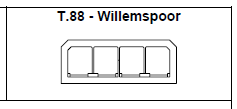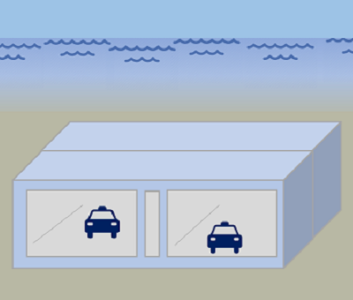Willemspoortunnel
HEIGHT: 8.62 m
WIDTH: 28.82 m
TOTAL IMMERSED LENGTH: 1,014 m
DEPTH AT BOTTOM OF STRUCTURE: - 17.5
ENVIRONMENTAL CONDITIONS:
Very difficult urban and marine constraints on construction. Heavily trafficed waterway.
Close to many sensitive existing structures and rail facilities.
FABRICATION METHOD:
Elements were fabricated in five or six 23 m segments
post-tensioned together. A cooling system was used.
Segments have large triangular shear keys shaped in the
vertical walls. Casting was done in an existing basin at
Barendrecht 30 km from tunnel site where several other
immersed tunnels have been built.
WIDTH: 28.82 m
TOTAL IMMERSED LENGTH: 1,014 m
DEPTH AT BOTTOM OF STRUCTURE: - 17.5
ENVIRONMENTAL CONDITIONS:
Very difficult urban and marine constraints on construction. Heavily trafficed waterway.
Close to many sensitive existing structures and rail facilities.
FABRICATION METHOD:
Elements were fabricated in five or six 23 m segments
post-tensioned together. A cooling system was used.
Segments have large triangular shear keys shaped in the
vertical walls. Casting was done in an existing basin at
Barendrecht 30 km from tunnel site where several other
immersed tunnels have been built.
Rotterdam,
Netherlands

Dutch Railway
KWT Joint Venture: Dirk Verstoep Rotterdam; Ballast Nedam; Hollandsche Beton en Water bouw; Strukton Beton bouw
Civil Engineering Division of Rijkswaterstaat
115-138m
1,014m
17.5m
Project construction
1994-04-30
8
Four tubes; one track each tube
8.62m
28.82m
Unusually difficult, restrictive urban and marine site. Elements placed between
cofferdam walls in some areas.
cofferdam walls in some areas.
Elements were fabricated in five or six 23 m segments
post-tensioned together. A cooling system was used.
Segments have large triangular shear keys shaped in the
vertical walls. Casting was done in an existing basin at
Barendrecht 30 km from tunnel site where several other
immersed tunnels have been built.
post-tensioned together. A cooling system was used.
Segments have large triangular shear keys shaped in the
vertical walls. Casting was done in an existing basin at
Barendrecht 30 km from tunnel site where several other
immersed tunnels have been built.
Outfitting for placement was
done in the casting basin.
Elements were ballasted to
keep them on the bottom
prior to placement. Each
was then floated individually
and towed to the site with
20 cm of freeboard. The trip
took one day. A catamaran
barge system was used for
placing.
done in the casting basin.
Elements were ballasted to
keep them on the bottom
prior to placement. Each
was then floated individually
and towed to the site with
20 cm of freeboard. The trip
took one day. A catamaran
barge system was used for
placing.
Very difficult urban and marine constraints on construction. Heavily trafficed waterway.
Close to many sensitive existing structures and rail facilities.
Close to many sensitive existing structures and rail facilities.
On the left (northwest) side of the Maas, the elements were lowered from girders. On
the right side, across the Nieuwe Maas, floating pontoons were used. The closure joint
was made between the last two elements.
the right side, across the Nieuwe Maas, floating pontoons were used. The closure joint
was made between the last two elements.
Gina/Omega
No waterproofing layers were used. Concrete segments were sized and designed to
prevent cracking, and careful concrete mix and temperature control were used for each
segment
prevent cracking, and careful concrete mix and temperature control were used for each
segment
Sand-flow foundation.
1.0 m protection
B30

